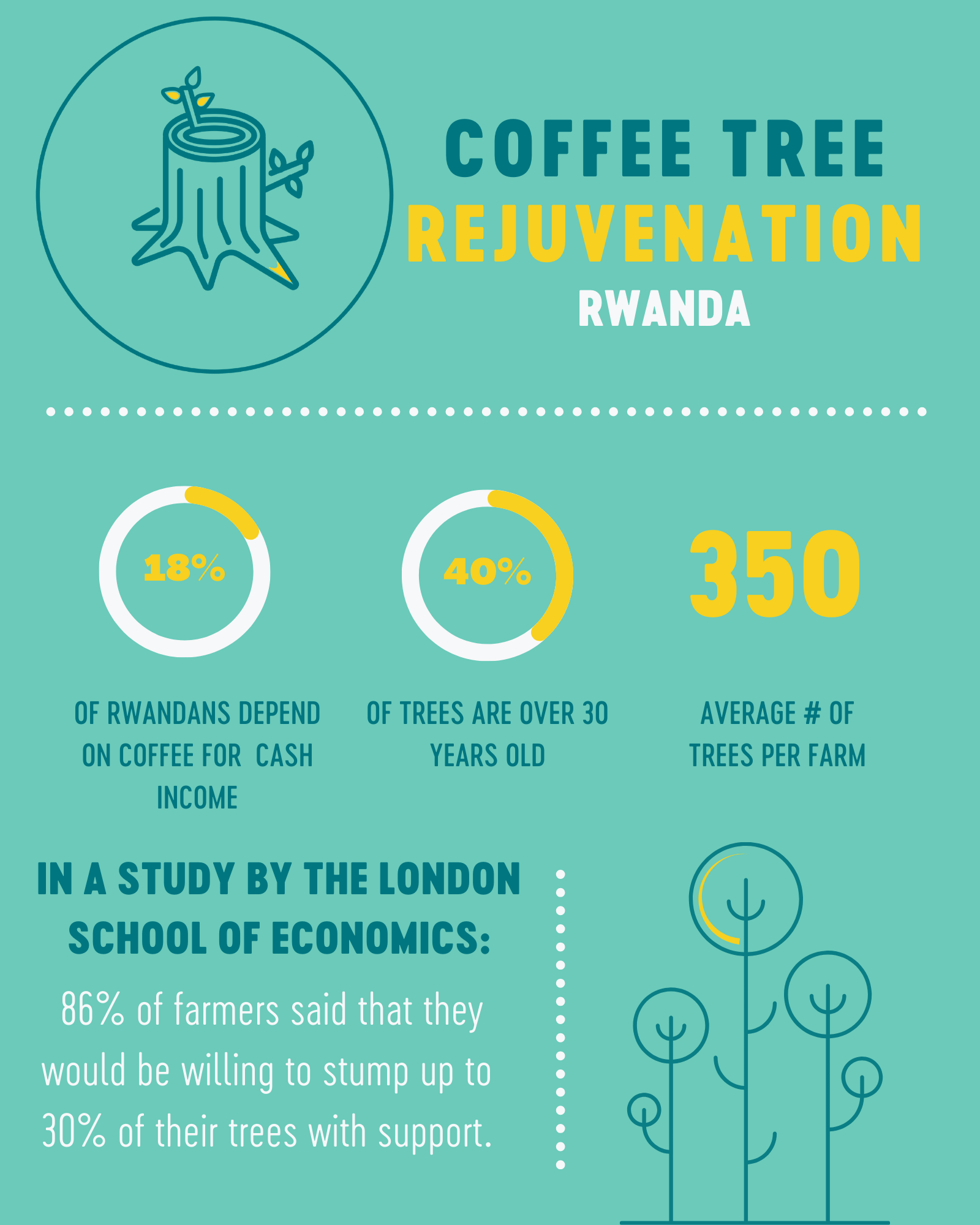Coffee Tree Rejuvenation in Rwanda
Now, by purchasing microlots from our sister company, RWACOF (Sucafina in Rwanda) and our Isimbi “Sucafina Original”, you are contributing to a project that’s helping farmers increase yields through stumping and renovation. Part of our Farmgate Initiative, this pilot program will combine soil analysis, agronomic advice and support on farms to help farmers attain higher yields.
Ready to learn about the rejuvenation project? Hear from farmers directly about how stumping is benefitting them in this video produced by RWACOF and LSE about the project.
The average yield per tree in Rwanda is low and most farmers only achieve around 1 kilogram of cherry per tree. That’s compared to an average of 2 to 3 kg per tree in other origins, such as Colombia.

Purchases of microlots from RWACOF and our Isimbi "Sucafina Original" all contribute to this project. Contributions across our Europe, Asia Pacific (Australia) and North America offices will amount to over USD$30,000. Partner farmers will be able to renovate or stump over 255,000 trees with these contributions. In addition to the technical and monetary support from RWACOF, we believe that enrolled farmers will see positive results from renovation and will choose to progressively renovate the rest of their farms to increase overall yields.
Before beginning the project, RWACOF and our partner, the London School of Economics (LSE), worked with farmers to determine the best way to support their goals and address specific coffee farm needs. LSE conducted a phone survey of 66 farmers to ask them multiple questions about their tree age, health and their individual appetite for renovation. Of those surveyed, 86% said yes, they would like to renovate a portion of their trees if they were given the labor and support to do this successfully. In particular, the LSE study helped determine the percentage of a farm that RWACOF would help farmers renovate. The average portion of their farm that farmers were willing to stump (given the support) was about 30% and the program was built around those preferences.
Depending on the health and age of their trees, farmers will either stump or replace selected trees. Stumping – cutting the tree down to the base of the trunk – can be a quicker way to increase yields, compared to uprooting the entire tree. Once stumped, the tree typically regrows and begins bearing fruit again in about 2 years. Stumped trees typically bear higher yields than they did before they were stumped. When trees are older and stumping is not a viable option, farmers can uproot the entire tree and replant a new seedling in its place. New seedlings typically take 3 years to bear fruit, though some varieties do bear fruit after just 2 years. Since stumping can produce results faster, it can be a valuable tool to increase yields while minimizing the loss of income for farmers.
Beginning in July 2023, the agronomy team called 5,237 farmers and invited them to register for the tree rejuvenation program. Of those, 1,136 signed up for the program and, in total, committed to renovating 262,392 trees. Farmers receive 50 Rwandan Francs (about 4 US cents) per tree renovated to help offset labor costs. Farmers also receive lime and fertilizer 6 months after renovation to fuel growth and can access stumping tools for free at participating washing stations. Farmers will be able to improve the yields of the existing trees while also cultivating the new seedlings.
Want to contribute to this program and support even more farmers? Contact your trader to learn more about this project and how you can become a part of our Farmgate Initiatives.
Related coffees:
Isimbi FW FTO Farmgate Initiative: Sucafina Originals
Isimbi FW: Sucafina Originals Farmgate Initiative
Isimbi FW: Sucafina Originals Farmgate Initiative IMPACT
Isimbi FW: Sucafina Originals Farmgate Initiative Organic
Isimbi FW: Sucafina Originals RFA Farmgate Initiative
Isimbi FW: Sucafina Originals RFA Organic Farmgate Initiative
Ituze Women’s Cooperative FW Farmgate Initiative
Karambi Anaerobic FW Farmgate Initiative
Karambi Anaerobic Honey Farmgate Initiative
Karambi Fully Washed Farmgate Initiative
Karambi Natural Farmgate Initiative
Kayumbu FW Farmgate Initiative
Kayumbu Natural Farmgate Initiative
Kibirizi FW Farmgate Initiative
Kibirizi Honey Farmgate Initiative
Musasa FW FTO Farmgate Initiative
Musasa FW Organic Farmgate Initiative
Musasa Natural Farmgate Initiative
Musasa Natural Organic Farmgate Initiative
Mushonyi Anaerobic Honey Farmgate Initiative
Mushonyi FW Farmgate Initiative
Ngororero FW Farmgate Initiative
Nyakarenzo Natural Farmgate Initiative
Nyamyumba FW Farmgate Initiative
Nzahaha Natural Farmgate Initiative